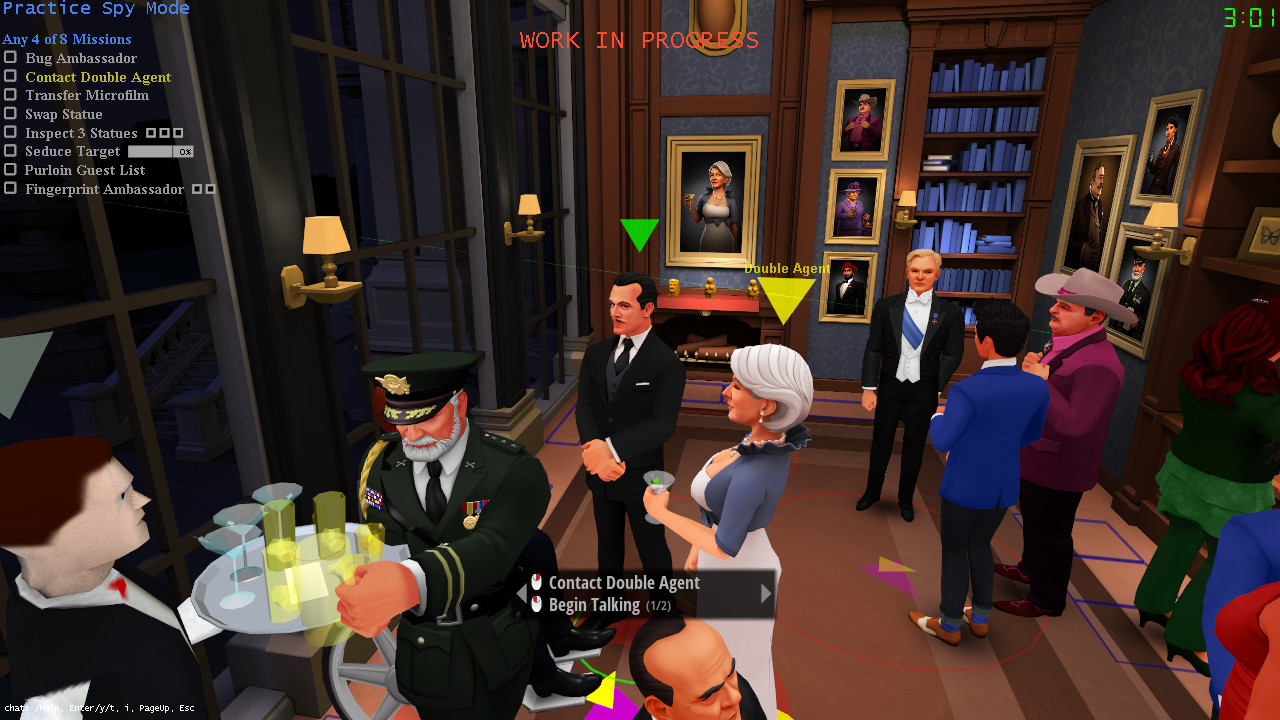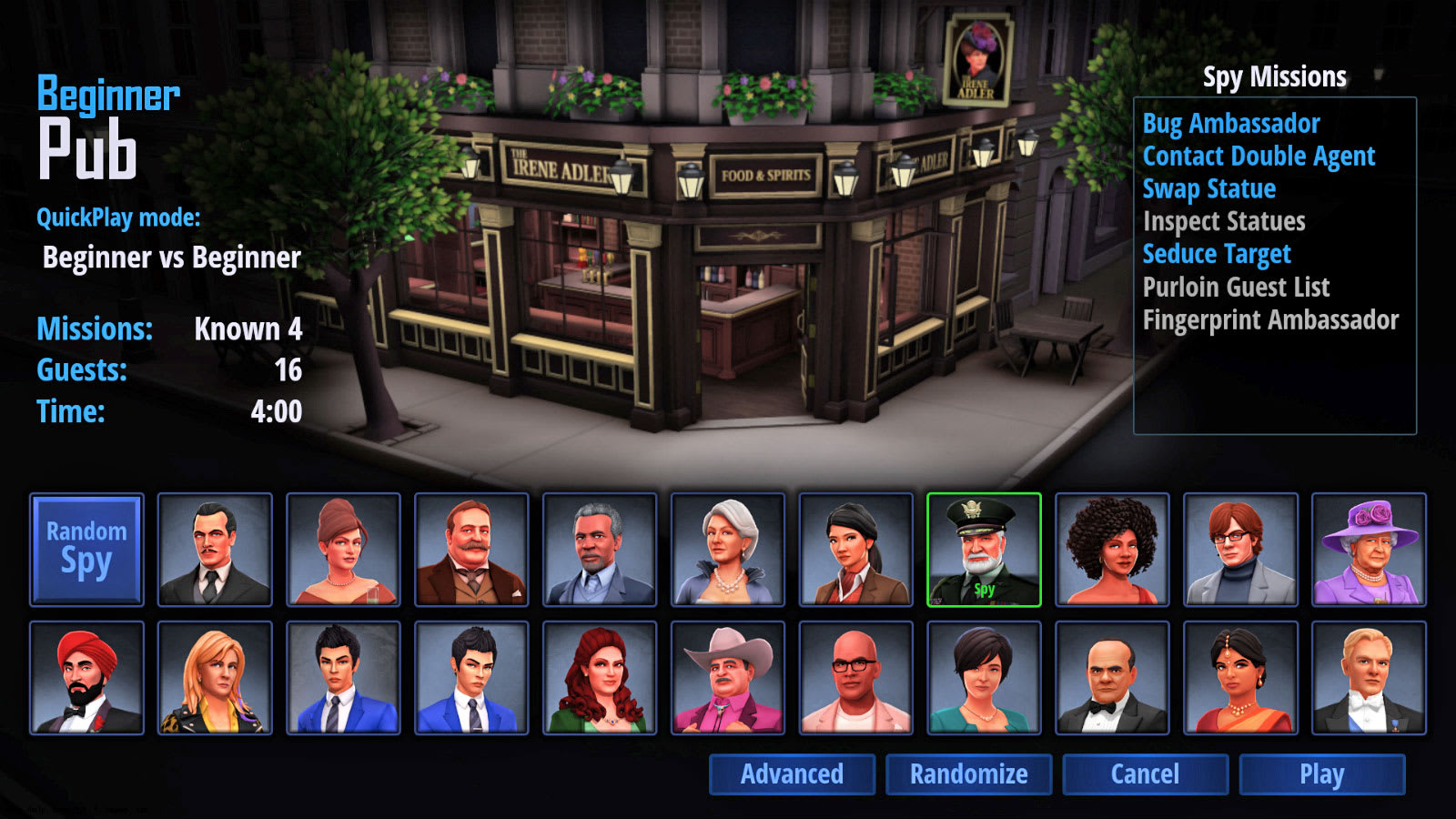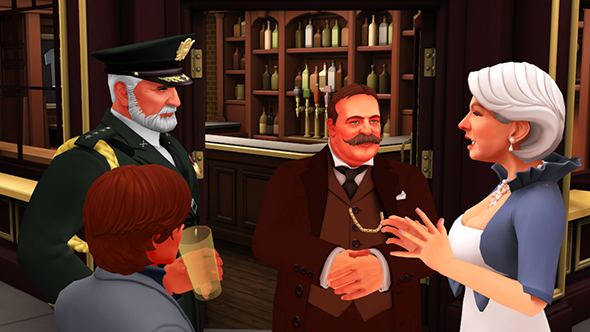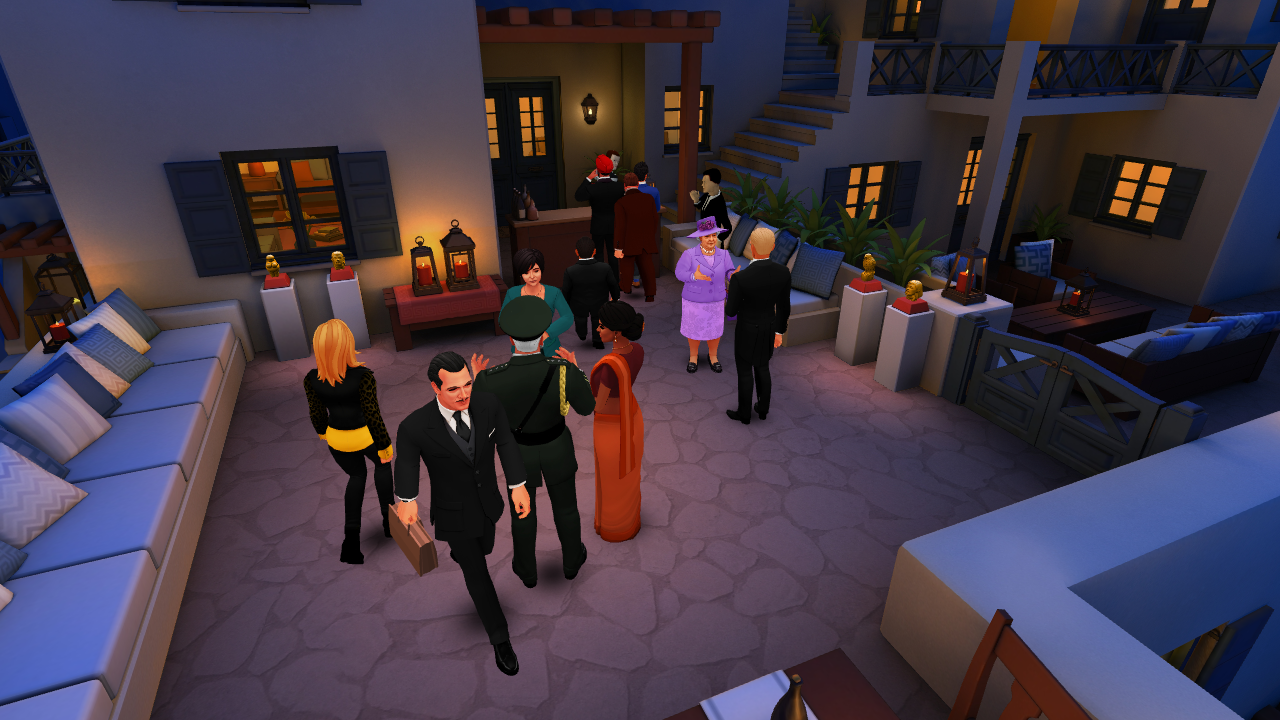A networked, asymmetric duel of deception, SpyParty is what Hecker likes to call a "reverse Turing test." One player, the spy, attempts to blend in with the crowd at a cocktail party while indulging in such infamous plenipotentiary antics as seducing the Queen of England, blurting out non sequiturs, and pretending to read books before putting them back in the wrong shelf. Player 2, as the sniper, watches in on the affair from a distance, trying to sniff out their human enemy among the motley jumble of schmoozing NPCs.
The spy has a checklist of missions. The sniper has one shot. 3 minutes, give or take, on the clock.
Will the spy go undetected?
Will the sniper shoot on a hunch?
Will an innocent civilian eat a lead hors d'oeuvre?
Will the spy go undetected?
Will the sniper shoot on a hunch?
Will an innocent civilian eat a lead hors d'oeuvre?
It's a million dollar idea. A premise from on high. And, having gotten my hands dirty this last year dead dropping microfilms and zooming in on ambassadors' asses, I'm struck more and more not just by the game's elegant high concept but by the genuinely sui generis and even quietly subversive ingenuity of its execution, from the density of visual detail to the unorthodox control scheme.
Before we get into the practicals, though, I do think a bit of pipe puffing is in order.
Before we get into the practicals, though, I do think a bit of pipe puffing is in order.
Panoptic con
Hopefully the elevator pitch was enough to get your inner philosopher pulling his beard. Passing oneself off as a bot in a limited attention surveillance theater e-sport? Come on, everybody. That's profound.
And it's not just a clever concept. SpyParty is at every moment a tense and demanding thriller. Sweating under the spotlight of your own self-centering biases. Deciding, dizzy and desperate, which stop to get off the Yomi Express. Pinning back your eyelids, fumbling your mnemonics, praying your last-ditch frame job sticks, all while playing what looks like a Clue expansion for The Sims.
Chris Hecker has been vocal over the years about the lip service that gets paid to video games' potential for storytelling while the same old orcs and elves get their subsurface scattering glow up. It might seem funny that Hecker putting his money (literally his savings from Maxis and then some) where his mouth is has resulted in a Poker-like indie e-sport. But if anything I think this proves that if you're serious about embracing the ludic possibilities of subtle, human-scale behavior, of a whole branch low down on the tree of games heavy with sweet, ripe fruit—that branch being etiquette—then you simply must attend this party.
Playing it cool
The crux of SpyParty's distinction, its fundamental contrivance, is the unambiguous asymmetry of the actor/spectator dynamic. While titles like Assassin's Creed: Brotherhood or The Ship ventured into the waters of hiding in plain sight via NPC pantomime, SpyParty's explicit separation of the two roles (plus the way it condenses the stage and roster of suspects) opens up a shocking amount of room for deep, granular, highly skilled play.
Newbies sometimes have a hard time acclimating to this seriousness. They might think that it's nothing but character selection shenanigans, or the sniper, say, forgets that they win if the spy doesn't complete missions. It's not that the game doesn't allow for cheeky maneuvers, it just takes a little commitment to fathom what's being asked of you, to mentally corral the various checks and balances, to appreciate the calligraphy on the cordial invitation, even if you, irredeemable slob that you are, feel you must decline.
So while some might bounce off a competitive multiplayer video game simply for expecting you to complete a tutorial, the more or less level playing field SpyParty offers new players is, to my mind, worth the preceptial front-loading—personally it's a blessing to be evenly matched playing friends who would normally have me in a toe hold within the first thirty seconds. SpyParty's emphasis on empathy and composure likewise facilitates a refreshingly mature community spirit, one which stresses mentoring, analysis, self-awareness and civility over locker room shit talk and bloody knuckled woodshedding.
Not to suggest that there's no dexterity involved. Actually the proportion of "micro" gives SpyParty much of its unusual texture. Spies don't just click on their desired destination as in an RTS but must be steered there manually, taking slow, purposeful, realistic strides (or wheel-spins if you're Wheels) toward outlined floor pads or conversation circles, careful not to stop until their feet are planted securely within one of these delimited zones. Once inside, they're presented with a scrollable list of binary options: an innocent action (one that can be done by the other partygoers) and a spy action (one that cannot, and that often helps to further mission progress). Choose to perform a spy action and you'll be prompted with a Gears of War reload-style "action test": hit green and your legerdemain will be near-invisible; hit white and there may be a tell; hit red and... where'd that waiter go with the drinks? All the while, you'll be swiveling the camera around, getting a read of the room, seeing who's where, and planning your next move.
It feels weird at first. Well, that feeling is called radical game design. Third person puppetry estranged and reconstructed. And though timing is critical and you'll want to have a good "bounce"/redirect path in your toolkit, micro stays micro—present but subordinate.
The sniper gets to click some buttons too. Besides panning and zooming, they can highlight guests they want to keep an eye on or lowlight those who, like the bartender, they know couldn't possibly be the spy. Why don't more first-person games let players use raycasts for flagging, tagging, and sorting visual hierarchies? A valuable bit of sniper tech is focusing your laser somewhere other than where you're looking. Why don't more first-person games get players to look away from the center of the screen? Radical.
Alternating between the two modes each game helps keep fatigue at bay by shifting stress to different loci. As I hinted at earlier, the genius of SpyParty's execution lies in its heterogeneity. Not just between the principle roles, but among its selection of missions, venues, and characters.
Newbies sometimes have a hard time acclimating to this seriousness. They might think that it's nothing but character selection shenanigans, or the sniper, say, forgets that they win if the spy doesn't complete missions. It's not that the game doesn't allow for cheeky maneuvers, it just takes a little commitment to fathom what's being asked of you, to mentally corral the various checks and balances, to appreciate the calligraphy on the cordial invitation, even if you, irredeemable slob that you are, feel you must decline.
So while some might bounce off a competitive multiplayer video game simply for expecting you to complete a tutorial, the more or less level playing field SpyParty offers new players is, to my mind, worth the preceptial front-loading—personally it's a blessing to be evenly matched playing friends who would normally have me in a toe hold within the first thirty seconds. SpyParty's emphasis on empathy and composure likewise facilitates a refreshingly mature community spirit, one which stresses mentoring, analysis, self-awareness and civility over locker room shit talk and bloody knuckled woodshedding.
Not to suggest that there's no dexterity involved. Actually the proportion of "micro" gives SpyParty much of its unusual texture. Spies don't just click on their desired destination as in an RTS but must be steered there manually, taking slow, purposeful, realistic strides (or wheel-spins if you're Wheels) toward outlined floor pads or conversation circles, careful not to stop until their feet are planted securely within one of these delimited zones. Once inside, they're presented with a scrollable list of binary options: an innocent action (one that can be done by the other partygoers) and a spy action (one that cannot, and that often helps to further mission progress). Choose to perform a spy action and you'll be prompted with a Gears of War reload-style "action test": hit green and your legerdemain will be near-invisible; hit white and there may be a tell; hit red and... where'd that waiter go with the drinks? All the while, you'll be swiveling the camera around, getting a read of the room, seeing who's where, and planning your next move.
It feels weird at first. Well, that feeling is called radical game design. Third person puppetry estranged and reconstructed. And though timing is critical and you'll want to have a good "bounce"/redirect path in your toolkit, micro stays micro—present but subordinate.
The sniper gets to click some buttons too. Besides panning and zooming, they can highlight guests they want to keep an eye on or lowlight those who, like the bartender, they know couldn't possibly be the spy. Why don't more first-person games let players use raycasts for flagging, tagging, and sorting visual hierarchies? A valuable bit of sniper tech is focusing your laser somewhere other than where you're looking. Why don't more first-person games get players to look away from the center of the screen? Radical.
Alternating between the two modes each game helps keep fatigue at bay by shifting stress to different loci. As I hinted at earlier, the genius of SpyParty's execution lies in its heterogeneity. Not just between the principle roles, but among its selection of missions, venues, and characters.
Ambient occlusion
In most games of SpyParty, the spy must complete so many missions from a list of n, say 4 of 6. The sniper knows the 6 missions available, but not which 4 the spy will choose to complete, or in which order. Currently, the missions are:
- Bug Ambassador
- Fingerprint Ambassador
- Contact Double Agent
- Purloin Guest List
- Seduce Target
- Transfer Microfilm
- Inspect Statues
- Swap Statue
While some are obviously siblings, each has its own flavor, its own challenges, tells, opportunities and valences. Flowing from one into the next is such an art, such a deliciously subtle, supple groove to feel for, it makes most other games' goal-seeking feel wooden by comparison.
Seduce, for example, must be chipped away at by sidling up next to your target and triggering a standard talk animation; no tells to speak of, unless that voyeur watching through the window pairs you with your favorite conversation partner. These come-ons, however, are on a cooldown and must be spaced out, requiring you put some distance between yourself and your prey before swooping back in to seal the deal. Seduce Target is generally considered a freebie, the bread and butter of most spies' diet. It's a nice way to get things done while looking like you're doing nothing. But time management is a killer, and your Lothario might get the cold shoulder at just the wrong moment, forcing his once-leisurely self to give ungentlemanly chase.
Both players are constantly responding to the function's unceasing flow. The sniper's looking for patterns and exceptions in the human kaleidoscope. The spy is looking for cover. And what better disguise for this neutral alea than the ambient chaos of a (third) party?
One of the most important things the NPCs do is get in the way. This clip shows Carlos' cowboy hat conveniently blocking the disappearance of the guest list from the waiter's drink tray. Could the spy have possibly predicted that would happen? What? No. Of course not. But you roll with it.
Visibility is huge. Sightlines and occluders contribute significantly to the identity of each venue, from Teien's shōji to Courtyard's central pedestal to the most recent addition, Aquarium, with its great white shark swimming at intervals across the glass proscenium (placeholder till they secure Dopefish?).
But it's on Balcony where the theme of hiding in plain sight reaches a crescendo. Originally conceived as SpyParty's quickfire arcade variant, Hecker soon realized he'd underestimated how mischievous his brainchild can truly be. Balcony is SpyParty reduced to its essence. Tauntingly uncluttered, its laser-like focus reveals just how granular this stuff gets.
And while this venue arguably represents the apogee of SpyParty's fineness, the project's thorough commitment to subtlety, and to tastefulness in general, extends to ex-Maxis artist John Cimino's wonderfully realized characters and visuals—successes which might fly under the radar next to the game's other, more obvious distinctions.
Cocktails with the upper crust: dukes, directors, heiresses, barons. A jangling, clinking pageant of different bodies and costumes.
For a tightly focused, depth-obsessed indie game, SpyParty nails diversity on multiple fronts. In the missions, in the venues, in styles of play and kinds of players, but especially in its coterie of sharply dressed elites. Though many ethnicities, ages, and sensibilities are represented, the differences between each character end up being pretty minor. It's expected that the spy will (most of the time) randomly roll the cast for the match. If you're playing SpyParty for real, games will never boil down to simply guessing which socialite your opponent chose to pilot.
That being said, characters do have slight variations in width, height, walking speed, and animations for bugging the ambassador, and there are a few characters in particular who are, let's say, more different: Drs. M and N, AKA Plain Twin and Bling Twing, Mr. I AKA Wheels, and Mr. S AKA Smallman. The identical twins, obviously, are hard to tell apart, while Wheels' wheelchair and Smallman's dwarfism make them short enough to effectively hide behind other party members, enabling bolder tactics and even sometimes avoiding the sniper's bullet. Thankfully, SpyParty is (maybe not 100% but) essentially self-balancing via its prominent meta. On certain venues (like Gallery) and for certain snipers, these characters' predilection for cheese can earn them a highlight just for being who they are.
I think this works out pretty well. Should they have opted not to have a character in a wheelchair? Look at him, he's got a turtleneck, he looks like a mastermind. He just delegated a purloin and now he's rolling over to green bookcase to finish up his flirt! While the most physically anomalous characters afford some of the cheekiest strategies and thus find themselves the butt of jokes more often probably than the others, this seems to be something the game's community is generally sensitive to, and refrains from cruelly or inappropriately elaborating. SpyParty doesn't pretend that everyone's the same, but the variance, like the micro, isn't overly determinative.
Cimino and Hecker's character designs showcase many of SpyParty's core themes: diversity, proportion, tastefulness, visual density, and humanism. The silhouettes (appreciable on Teien) are varied and distinct in a way that feels utterly natural for the fiction, but it's the faces that, on closer inspection, show some serious skill. The sculpting, shading, texturing, and animation is... it looks fine, it looks how it should look, right? But look at other video game characters. Now look again at SpyParty's. Skin tones are consistently warm and saturated, expressions are legible without being exaggerated, hair doesn't look like it's protruding noisily from some orthogonal universe. The identities of materials are subordinated to the identities of persons. Team Fortress 2 would be a fair comparison, though SpyParty's designs rely less on stylization, hitting on a lovely medium drawn in large part from 20th century fashion illustration.
While SpyParty on the whole pursues a humanistic naturalism, verisimilitude does take a couple little scratches here and there. Mainly it's the clipping: in a game about a bunch of people crowded in regular-sized rooms, grabbing drinks, gesticulating, and planting tracking devices on each other's buttocks, there's bound to be some body parts vying for similar territory. So, they clip. Pretty often. You get used to these bodies' hit boxes being smaller than in most other games, which, in its own way, bespeaks the intimacy embraced by Hecker's design, and the shrug he offers this basic problem bespeaks, I believe, his wisdom.
For a tightly focused, depth-obsessed indie game, SpyParty nails diversity on multiple fronts. In the missions, in the venues, in styles of play and kinds of players, but especially in its coterie of sharply dressed elites. Though many ethnicities, ages, and sensibilities are represented, the differences between each character end up being pretty minor. It's expected that the spy will (most of the time) randomly roll the cast for the match. If you're playing SpyParty for real, games will never boil down to simply guessing which socialite your opponent chose to pilot.
That being said, characters do have slight variations in width, height, walking speed, and animations for bugging the ambassador, and there are a few characters in particular who are, let's say, more different: Drs. M and N, AKA Plain Twin and Bling Twing, Mr. I AKA Wheels, and Mr. S AKA Smallman. The identical twins, obviously, are hard to tell apart, while Wheels' wheelchair and Smallman's dwarfism make them short enough to effectively hide behind other party members, enabling bolder tactics and even sometimes avoiding the sniper's bullet. Thankfully, SpyParty is (maybe not 100% but) essentially self-balancing via its prominent meta. On certain venues (like Gallery) and for certain snipers, these characters' predilection for cheese can earn them a highlight just for being who they are.
I think this works out pretty well. Should they have opted not to have a character in a wheelchair? Look at him, he's got a turtleneck, he looks like a mastermind. He just delegated a purloin and now he's rolling over to green bookcase to finish up his flirt! While the most physically anomalous characters afford some of the cheekiest strategies and thus find themselves the butt of jokes more often probably than the others, this seems to be something the game's community is generally sensitive to, and refrains from cruelly or inappropriately elaborating. SpyParty doesn't pretend that everyone's the same, but the variance, like the micro, isn't overly determinative.
Cimino and Hecker's character designs showcase many of SpyParty's core themes: diversity, proportion, tastefulness, visual density, and humanism. The silhouettes (appreciable on Teien) are varied and distinct in a way that feels utterly natural for the fiction, but it's the faces that, on closer inspection, show some serious skill. The sculpting, shading, texturing, and animation is... it looks fine, it looks how it should look, right? But look at other video game characters. Now look again at SpyParty's. Skin tones are consistently warm and saturated, expressions are legible without being exaggerated, hair doesn't look like it's protruding noisily from some orthogonal universe. The identities of materials are subordinated to the identities of persons. Team Fortress 2 would be a fair comparison, though SpyParty's designs rely less on stylization, hitting on a lovely medium drawn in large part from 20th century fashion illustration.
While SpyParty on the whole pursues a humanistic naturalism, verisimilitude does take a couple little scratches here and there. Mainly it's the clipping: in a game about a bunch of people crowded in regular-sized rooms, grabbing drinks, gesticulating, and planting tracking devices on each other's buttocks, there's bound to be some body parts vying for similar territory. So, they clip. Pretty often. You get used to these bodies' hit boxes being smaller than in most other games, which, in its own way, bespeaks the intimacy embraced by Hecker's design, and the shrug he offers this basic problem bespeaks, I believe, his wisdom.
Better attention
Whichever way the commercial cookie crumbles come 1.0, Chris Hecker is clearly playing the long game, and, despite my stomping on a print out of a hypothetical 7.5/10 review citing steep learning curve this, pedestrian presentation that, no single-player "campaign"—I think it's ultimately gonna work out.
Though probably low on memeability (and obviously without the backing of any sort of marketing team), a possible advantage that SpyParty's Hitchcockian theater has for broadcast is its psychological immediacy and delicious potential for dramatic irony; match commentary provided by casters like WarningTrack tries to explain the cognizance and intention of both players in a way that can make you the listener a better player and that helps to distinguish the current competitors as individuals.
There's more content planned too, of course. Something about the sniper activating the security guard. Dossiers for each character—General's, for example, letting you know that he never refuses a drink. Another mission or two, probably. All welcome, but the neat thing is that advanced game modes already feel impossible to get a complete handle on. Keeping track of 8 missions with all the commotion on Veranda or Moderne already scrapes painfully against the limits of homo sapiens' short-term memory. Guess we'll just have to evolve. Good thing Hecker works slow!
In a nearby universe, SpyParty is quaint. In this one, it's downright subversive. Rather than provoking boredom, its tastefully bland, thoroughly decent urbanity is refreshing, even brave. More refreshing still is the experience of actually playing it, of meeting its respectful demand for your complete attention, massaging out the default program of absurd fidgeting that other games have routed through your atrophied little brain.
Video games can be a wonderful way to reincarnate as some troglodytic mutant or wistfully sentient bumper car. To alienate your consciousness, induce hallucinations, wind you into rhythms that seem excavated from another biology. Not every game should be SpyParty. But it's such a welcome change of pace, such a deeply pleasant surprise, to have this android emissary for the human race mingling here on planet Video Game among the primordial Pac-Men.





